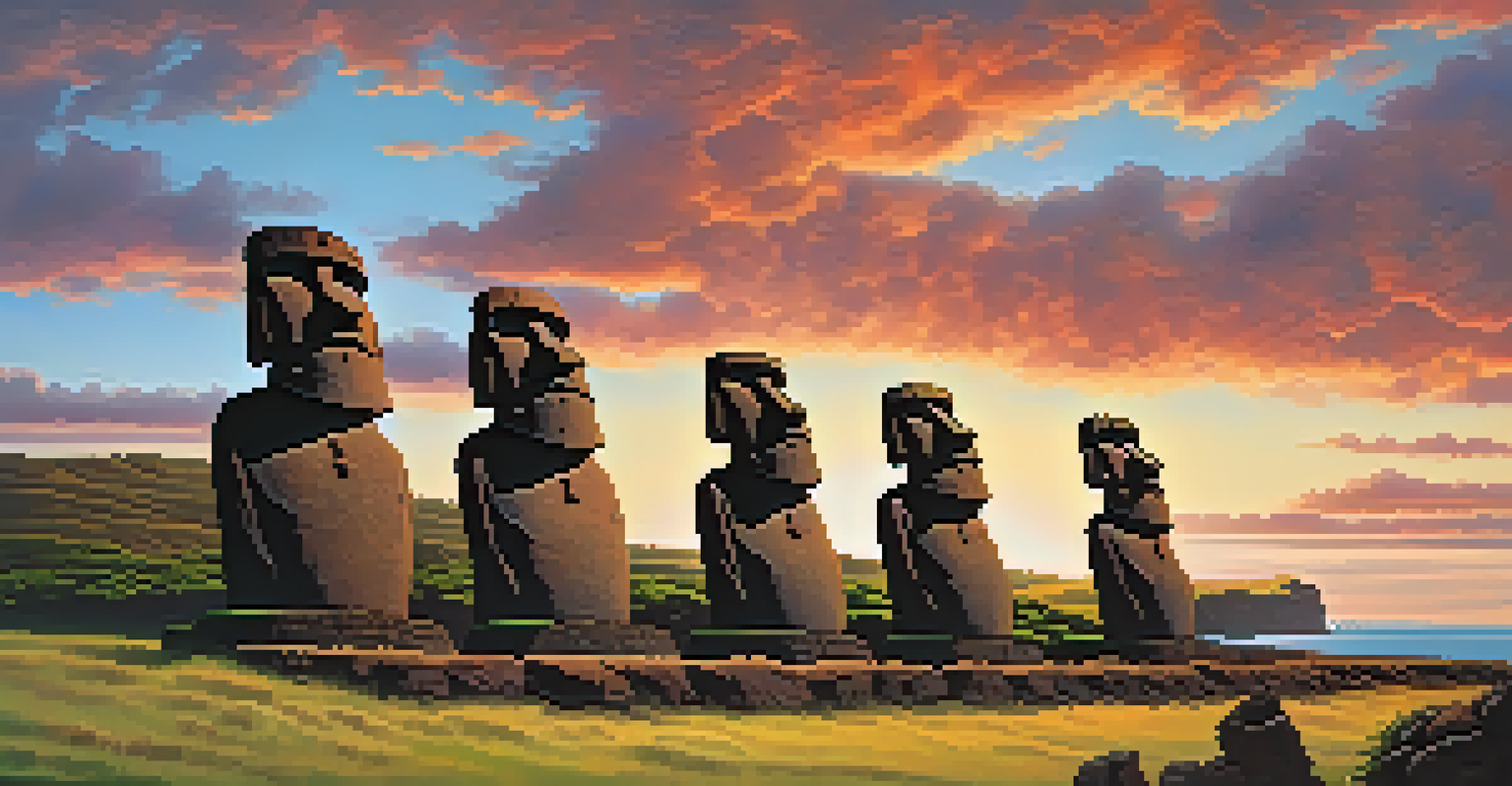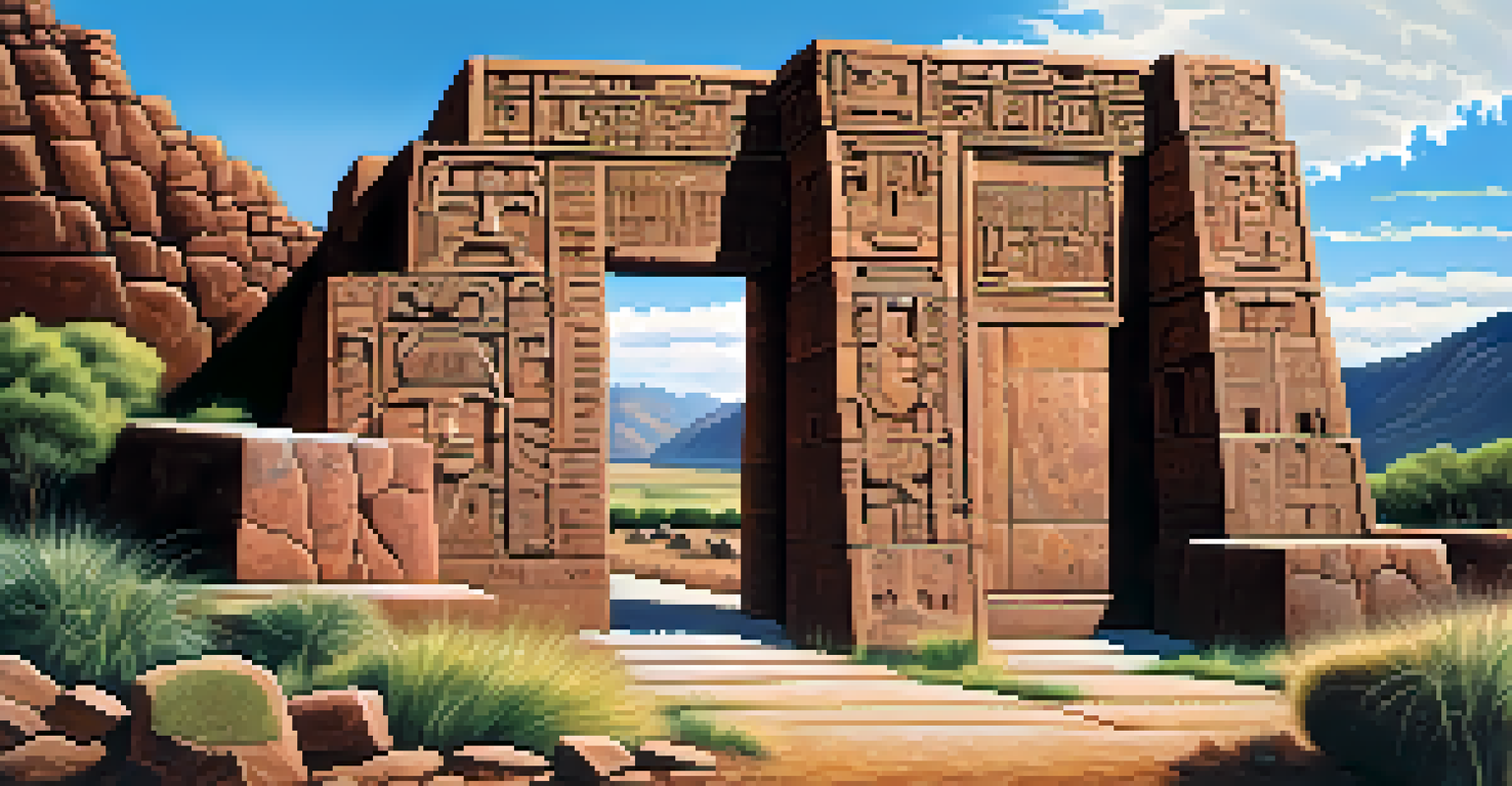Mysterious Ruins: Lesser-Known Archaeological Wonders to Visit

Exploring the Enigmatic Ruins of Hattusa in Turkey
Hattusa, the ancient capital of the Hittite Empire, is a treasure trove of history nestled in central Turkey. With its imposing stone walls and massive gates, the site offers a glimpse into a civilization that flourished over 3,000 years ago. Visitors can wander through the remnants of temples and royal archives, feeling the weight of history in every step.
Ancient ruins are the echoes of a once vibrant civilization, waiting for the curious to uncover their stories.
One of the most fascinating features of Hattusa is the Lion's Gate, adorned with impressive sculptures that have withstood the test of time. As you stand before these grand structures, it's easy to imagine the bustling life that once filled these ruins. The site’s layout, including the Great Temple dedicated to the Storm God, reveals the sophistication of Hittite architecture and urban planning.
To fully appreciate Hattusa, consider visiting during spring or autumn when the weather is mild. Guided tours often provide insights into the unique artifacts discovered on-site, enhancing your understanding of this remarkable civilization. Hattusa is not just a destination but an invitation to step back in time and explore the mysteries of an ancient world.
The Mysterious Moai Statues of Easter Island
Easter Island, or Rapa Nui, is famous for its iconic Moai statues, which stand as silent sentinels overlooking the Pacific Ocean. These massive stone figures, carved from volcanic rock, represent the ancestors of the island's inhabitants and are steeped in cultural significance. Each statue, some weighing over 80 tons, tells a story of craftsmanship and devotion.

Visiting Easter Island offers a unique blend of natural beauty and rich history. Imagine walking along the coastline, with the wind in your hair, as you encounter these majestic figures dotting the landscape. The mystery surrounding the methods of their transportation and erection adds an intriguing layer to your visit, sparking conversations about ancient engineering.
Explore Ancient Civilizations
Destinations like Hattusa, Tiwanaku, and Kuelap offer rich insights into the cultures and architectural prowess of ancient civilizations.
For a deeper dive into the local culture, consider participating in a guided tour that includes traditional music and dance performances. Engaging with the local Rapa Nui people can provide further insights into their customs and the legends surrounding the Moai. This journey to Easter Island is not just about seeing the statues; it's about connecting with a vibrant culture that continues to thrive.
Unveiling the Secrets of Tiwanaku in Bolivia
Tiwanaku, located near Lake Titicaca, is one of the most significant archaeological sites in South America, yet often overlooked by travelers. This ancient city was once a thriving center of civilization, showcasing impressive stonework and monumental architecture. Visitors can marvel at the Gate of the Sun and the intricate carvings that hint at the advanced skills of the Tiwanaku people.
Traveling through history is not just about seeing the past but experiencing the lives that shaped it.
The site’s layout reveals a deep understanding of astronomy and agriculture, with structures aligned to celestial events. As you walk through Tiwanaku, you may feel a sense of wonder at how these ancient peoples harnessed their environment for sustenance and spiritual practices. Each stone tells a story of connection to the earth and the cosmos.
To enrich your experience, consider visiting during a local festival when traditional ceremonies are held. This not only brings the ruins to life but also allows you to witness the enduring legacy of the Tiwanaku culture. A visit to Tiwanaku is a journey not just through history but into the heart of a civilization that shaped its land and people.
The Hidden Gem of Kuelap in Peru
Often overshadowed by Machu Picchu, Kuelap is an ancient fortress in northern Peru that deserves a spot on your travel itinerary. Built by the Chachapoya civilization, this impressive site is perched on a mountaintop and surrounded by stunning cloud forests. The fortress walls, some reaching 20 meters in height, are adorned with intricate stone carvings that reflect the artistry of its builders.
Exploring Kuelap feels like stepping into a forgotten world. As you hike through the lush vegetation to reach the site, anticipation builds for the breathtaking views and the mysteries that await. The vast complex includes numerous circular structures, each hinting at the social and spiritual life of the Chachapoya people.
Connect with Local Cultures
Engaging with local traditions and guided tours enhances the experience at sites like Easter Island and Angkor Wat.
To make the most of your visit, consider taking a cable car that offers panoramic views of the surrounding landscape. Engaging a local guide can provide valuable context about the site's history and its significance in the broader narrative of Andean civilizations. Kuelap is not just an archaeological site; it's a testament to the resilience and ingenuity of the people who once thrived there.
The Ancient City of Petra: A Marvel of Engineering
Petra, known as the Rose City, is a UNESCO World Heritage site in Jordan that captivates visitors with its stunning rock-cut architecture. This ancient Nabatean city, carved into the rose-red cliffs, was a vital trading hub in its time. As you approach the iconic Treasury, the sight of its elaborate facade emerging from the rock is nothing short of breathtaking.
The intricate water conduit system that supported Petra’s inhabitants showcases the advanced engineering skills of the Nabateans. Walking through the narrow Siq, you can almost hear the echoes of the past, imagining traders and travelers who once traversed this route. Each structure, from temples to tombs, reflects a unique blend of cultures and influences.
For an unforgettable experience, consider visiting Petra at sunrise or sunset when the colors of the rocks transform dramatically. Guided tours often include lesser-known sites within Petra, such as the Monastery, which offers a stunning viewpoint. Petra invites you to explore its mysteries while marveling at the ingenuity of a civilization that thrived in a harsh desert environment.
The Lost City of the Incas: Choquequirao
Choquequirao, often referred to as the 'sister city' of Machu Picchu, is a breathtaking Incan site nestled in the Andes of Peru. While Machu Picchu draws the crowds, Choquequirao remains a lesser-known gem, offering a more tranquil experience amidst stunning mountain vistas. The site features impressive stone terraces and a complex layout that showcases the ingenuity of Incan architecture.
Hiking to Choquequirao is an adventure in itself, with trails that wind through lush landscapes and offer spectacular views of the surrounding mountains. As you ascend, the anticipation builds, and the reward is a feeling of discovery as you explore the expansive ruins. Each corner reveals new structures, from temples to agricultural terraces, hinting at a vibrant community that once thrived here.
Adventure Awaits in Lesser-Known Sites
Sites like Choquequirao and Tikal provide breathtaking landscapes and a sense of discovery away from tourist crowds.
To make the most of your visit, consider camping overnight to catch the sunrise over the ruins. Guided treks often include insights into the history and significance of Choquequirao, enriching your understanding of this remarkable site. A trip to Choquequirao is not just about the destination; it's about the journey into the heart of Incan history and culture.
The Fascinating Ruins of Tikal in Guatemala
Tikal, one of the most significant ancient Mayan cities, is located deep in the jungles of Guatemala. This sprawling site boasts towering temples, impressive plazas, and a wealth of wildlife that creates a unique atmosphere. Walking among the ruins, you can almost hear the echoes of a once-thriving civilization that reached its peak between 600-900 AD.
The Temple of the Great Jaguar stands as a testament to Mayan architectural prowess, rising dramatically above the jungle canopy. As you climb its steep steps, the view from the top reveals the vastness of the surrounding rainforest, dotted with other temple ruins. The intricate carvings and stelae throughout the site provide glimpses into the Mayan way of life, including their rituals and social structure.

For an immersive experience, consider visiting Tikal early in the morning when the wildlife is most active and the air is crisp. Guided tours often include stories and insights into the significance of the site’s structures, enhancing your understanding of this ancient civilization. Tikal is not just a place to visit; it’s an invitation to connect with the history and culture of the Mayans.
The Enigmatic Ruins of Angkor Wat in Cambodia
Angkor Wat is perhaps one of the most recognized archaeological sites in the world, but within its vast complex lie many lesser-known gems. This UNESCO World Heritage site, originally built as a Hindu temple, later transformed into a Buddhist center, showcases stunning architecture and intricate bas-reliefs. Exploring Angkor is like stepping into a living museum of Khmer history and culture.
Hidden among the trees, you'll find temples like Ta Prohm, embraced by nature, where massive tree roots intertwine with the ancient stones. This enchanting atmosphere evokes a sense of mystery and wonder, inviting you to ponder the passage of time. Each temple tells a story, reflecting the artistry and spirituality of the Khmer civilization.
To fully appreciate Angkor Wat, consider spending multiple days exploring its many sites. Guided tours often provide insights into the historical significance and architectural brilliance of each temple. Visiting at sunrise or sunset can enhance your experience, as the golden light casts a magical glow on the ruins, making Angkor Wat a truly unforgettable destination.